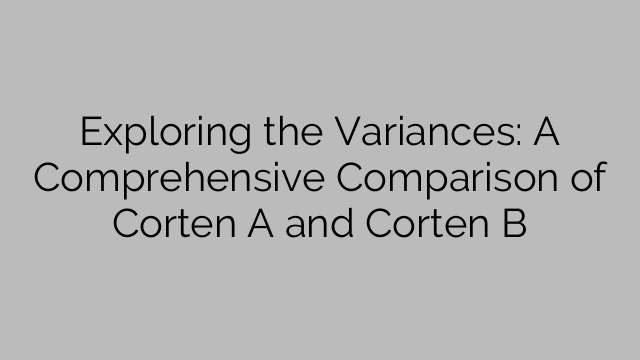When it comes to selecting the right material for construction or outdoor art installations that require durability and weather resistance, Corten steel often comes to mind. Renowned for its distinctive rusty appearance and ability to withstand the elements, Corten steel has become a popular choice among architects, engineers, and artists alike. However, there are two variants of Corten steel – Corten A and Corten B. In this article, we will delve into a comprehensive comparison between the two, exploring their variances and applications.
化学組成:
Corten A and Corten B share a similar chemical composition but differ slightly in their levels of certain elements. Corten A primarily consists of iron with small amounts of copper, chromium, and nickel, while Corten B contains slightly higher levels of phosphorus and manganese. These variances in composition have notable effects on the steel’s corrosion resistance and mechanical properties.
Corrosion Resistance:
Both Corten A and Corten B offer exceptional corrosion resistance due to the formation of a protective rust layer on the surface, commonly referred to as the patina. The patina acts as a barrier, preventing further oxidation and protecting the steel from atmospheric corrosion. However, Corten B displays improved resistance to corrosion compared to Corten A, primarily due to its higher phosphorus content.
機械的性質:
In terms of mechanical properties, Corten A and Corten B also exhibit slight differences. Corten A boasts higher tensile strength and yield strength, making it ideal for structural applications requiring greater strength. On the other hand, Corten B offers better elongation at break, providing superior ductility and allowing it to be formed into more complex shapes. Therefore, the choice between the two variants largely depends on the specific requirements of the project.
用途:
The applications of Corten A and Corten B can vary depending on these differences in composition and mechanical properties. Corten A is commonly used in structural and architectural applications, such as bridges, buildings, and outdoor sculptures. Its higher strength makes it suitable for load-bearing structures. On the contrary, Corten B finds application in cladding, facades, and smaller decorative elements that require a higher level of formability.
Maintenance and Longevity:
While Corten steel is known for its low maintenance requirements, it is essential to consider the intended use and environment of the installation. Both Corten A and Corten B require periodic cleaning to remove debris or pollutants that could prevent the formation of the protective patina. It is also crucial to note that the patina formation can take several months to develop fully.
Overall, choosing between Corten A and Corten B depends on various factors, such as desired aesthetics, structural requirements, and availability. Architects and designers must consider the specific project needs when determining which variant to use. Consulting with suppliers or experts in Corten steel can help in understanding the nuances and making an informed decision.
In conclusion, Corten A and Corten B are two variations of Corten steel that offer remarkable resistance to corrosion and serve different purposes based on their composition and mechanical properties. While Corten A is ideal for structural applications, Corten B excels in formability and is suitable for decorative elements. By thoroughly comprehending their differences, professionals can utilize these variants to their full potential and create long-lasting, visually appealing, and durable constructions or art installations.
[ad_2]

